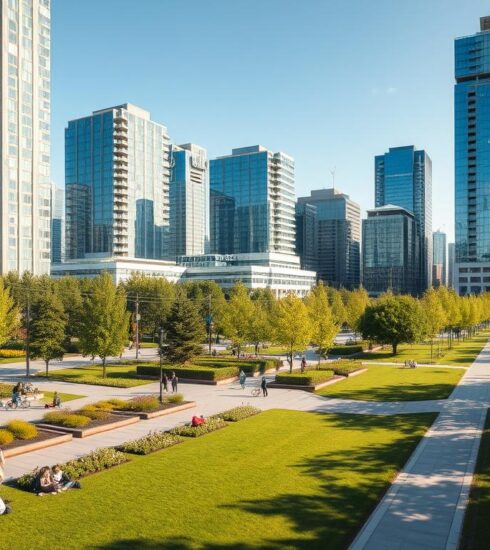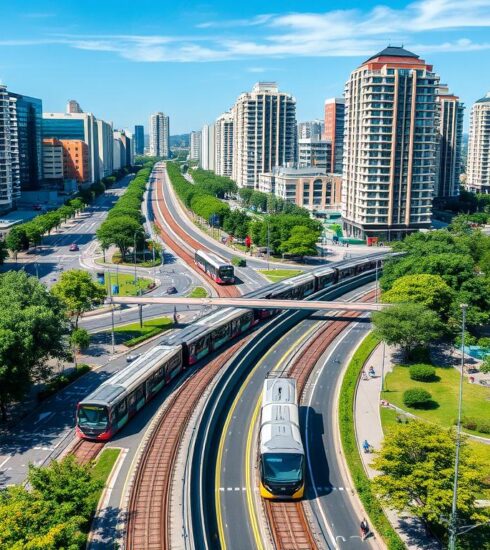Timeless Cities: How Urban Design Preserves History While Embracing Change
- Jackie De Burca
- November 18, 2024
The essence of a city lies not just in its modern architecture or bustling streets, but in the intricate tapestry of its urban fabric. This fabric, woven with threads of history, culture, and innovation, shapes the character and identity of a place. Urban design plays a crucial role in preserving the past while adapting to the present and future needs of a city1.
Across the globe, cities are demonstrating how thoughtful urban planning can strike a delicate balance between preserving historical heritage and embracing contemporary progress. From Barcelona’s modernist masterpieces to Singapore’s sustainable infrastructure, urban designers are finding innovative ways to integrate the old and the new, creating vibrant, liveable spaces that honour the past while catering to the demands of the present1.
The analogy of a city as a grand tapestry is a powerful one, for each thread – be it a landmark building, a bustling public square, or a network of pedestrian-friendly streets – is intricately woven into the larger urban fabric. Understanding and respecting this intricate web of elements is essential for cities seeking to undergo sustainable development, ensuring that the rich history and cultural identity of a place are not lost in the pursuit of progress1.
Key Takeaways
- Urban design plays a crucial role in preserving a city’s historical heritage while adapting to modern needs.
- Cities worldwide are demonstrating innovative approaches to integrating the old and the new, creating vibrant, liveable spaces.
- Understanding the intricate urban fabric is essential for sustainable development that respects a city’s cultural identity.
- Thoughtful urban planning can strike a balance between preserving the past and embracing contemporary progress.
- The analogy of a city as a grand tapestry highlights the interconnectedness of urban elements that shape a place’s character.
The Essence of Urban Design in Historical Context
Urban design is a multifaceted endeavour that blends art, science, and history to shape the way we experience our cities2. Tracing its origins back to ancient civilisations like Rome and Greece, the field of urban planning has evolved over centuries, responding to the changing needs of societies3. This section delves into the historical influences that have sculpted urban design, shedding light on how the past informs the present and future of our cities.
Defining Urban Design
At its core, urban design is the art of creating and shaping public spaces, from bustling city centres to quiet neighbourhoods. It encompasses the planning, design, and management of the built environment, with the ultimate goal of enhancing the quality of life for urban dwellers2. This discipline draws upon a diverse range of disciplines, including architecture, landscape architecture, civil engineering, and urban planning, to create cohesive and functional urban landscapes.
Historical Influences on Urban Planning
The evolution of urban design has been shaped by the unique challenges and cultural influences of different eras3. In the post-war period, for instance, car-oriented city planning led to high traffic volumes and air pollution, highlighting the need for more sustainable and people-centric approaches2. Similarly, the High Line project in New York City demonstrated how the repurposing of abandoned infrastructure can transform urban spaces and foster community engagement2. Across the globe, cities like Medellín, Colombia, have showcased the power of strategic urban design initiatives to improve the quality of life for their residents2.
As cities continue to grow and evolve, urban design plays a crucial role in addressing complex challenges, from social inequality and housing shortages to environmental sustainability2. By drawing inspiration from historical precedents and adapting to contemporary needs, urban planners and designers strive to create vibrant, livable, and culturally rich urban environments that preserve the essence of a city’s heritage while embracing the demands of the modern world.
“Urban design is not just about the physical form of a city, but about the way it functions and the experience it creates for its inhabitants.”
The Role of Preservation in Urban Design
Preservation is integral to sustainable urban development, maintaining a city’s unique identity and heritage while accommodating growth and change4. Urban conservation involves the preservation and protection of historic, cultural, and architectural resources in urban areas, encompassing buildings, streetscapes, neighbourhoods, and natural landscapes4. This holistic approach focuses on preserving entire districts rather than individual structures, providing insights into past ways of life and historical significance.
Balancing Modernity and Heritage
4 Adaptive reuse, a major trend in urban conservation, involves repurposing historic buildings for new uses while maintaining their historical significance5. Restoration of older buildings for reuse is more labour-intensive than materials-intensive, providing more jobs5. Urban conservation can also save up to 50 percent on the cost of building a new structure5. This balance of modernity and heritage can revive depressed commercial areas of cities, attracting higher-income residents and new businesses5.
Case Studies of Successful Preservation
4 Case studies of successful urban conservation projects include the restoration of the Old Town of Quito, adaptive reuse of the Gasometer in Vienna, redevelopment of Battersea Power Station in London, revitalisation of the El Born neighbourhood in Barcelona, and preservation efforts in the ancient city of Yazd6. Washington, D.C. also has a strong history of historic preservation, with seventy historic districts and more than thirty local neighbourhoods designated as historic areas6. Balancing historic preservation requirements with competing interests like affordable housing, climate resilience, and high-performance building standards is crucial in successful urban planning.

4 The Conservation Management Plan is a comprehensive strategy guiding the sustainable preservation and adaptation of built heritage4. Integration of new technologies like BIM and digital documentation is increasingly common in urban conservation projects to aid in better understanding and managing historic buildings4. Community engagement is vital in urban conservation efforts, ensuring local needs and priorities are considered in conservation projects.
| City | Successful Preservation Efforts |
|---|---|
| Quito, Ecuador | Restoration of the Old Town |
| Vienna, Austria | Adaptive reuse of the Gasometer |
| London, UK | Redevelopment of Battersea Power Station |
| Barcelona, Spain | Revitalisation of the El Born neighbourhood |
| Yazd, Iran | Preservation efforts in the ancient city |
| Washington, D.C., USA | Seventy historic districts and over thirty local historic neighbourhoods |
“Preservation is integral to sustainable urban development, maintaining a city’s unique identity and heritage while accommodating growth and change.”
Iconic Architectural Styles and Their Stories
The built environment of our cities is a tapestry woven with threads of history, each architectural style a unique narrative that has shaped the urban landscape. From the grandeur of Victorian marvels to the minimalism of Modernist movements, these iconic designs have left an indelible mark on our architectural heritage.
Victorian Marvels
The Victorian era, spanning the reign of Queen Victoria from 1837 to 1901, witnessed a flourishing of architectural styles that continue to captivate us today7. The Stonehenge in Amesbury, United Kingdom, dating back to approximately 2,400 BCE, and the Silbury Hill in Wiltshire, United Kingdom, completed in the late Neolithic period, are two examples of the enduring presence of historical architecture in urban design7. These grand, ornate structures, with their intricate details and ornamental facades, have become synonymous with the cultural identity of many cities, serving as beacons of a bygone era.
Modernist Movements
In stark contrast to the ornate Victorian aesthetic, the Modernist movements of the early 20th century championed a radical shift towards simplicity and functionality8. The Bauhaus design school, founded in Germany in 1919, advocated for a minimalist approach that prioritised form and function over decorative elements8. This sleek, utilitarian style has left an indelible mark on urban design, with iconic buildings such as the Bauhaus-Archiv in Berlin and the Villa Savoye in Poissy, France, standing as testaments to the enduring influence of Modernist architecture.
Gothic Landmarks
Towering cathedrals and grand civic buildings adorned with intricate stone carvings and soaring spires have long been a defining feature of many European cities9. Stonehenge in England, a prehistoric stone circle, showcases ancient construction techniques and mystery, while cliff dwellings like those in Mesa Verde, Colorado, illustrate early sustainable design practices9. The Basilica of St. Sernin in Toulouse, France, constructed between 1070 and 1120, stands as a testament to the enduring allure of Gothic architecture, its pointed arches and ribbed vaults inspiring awe and wonder in all who behold it.
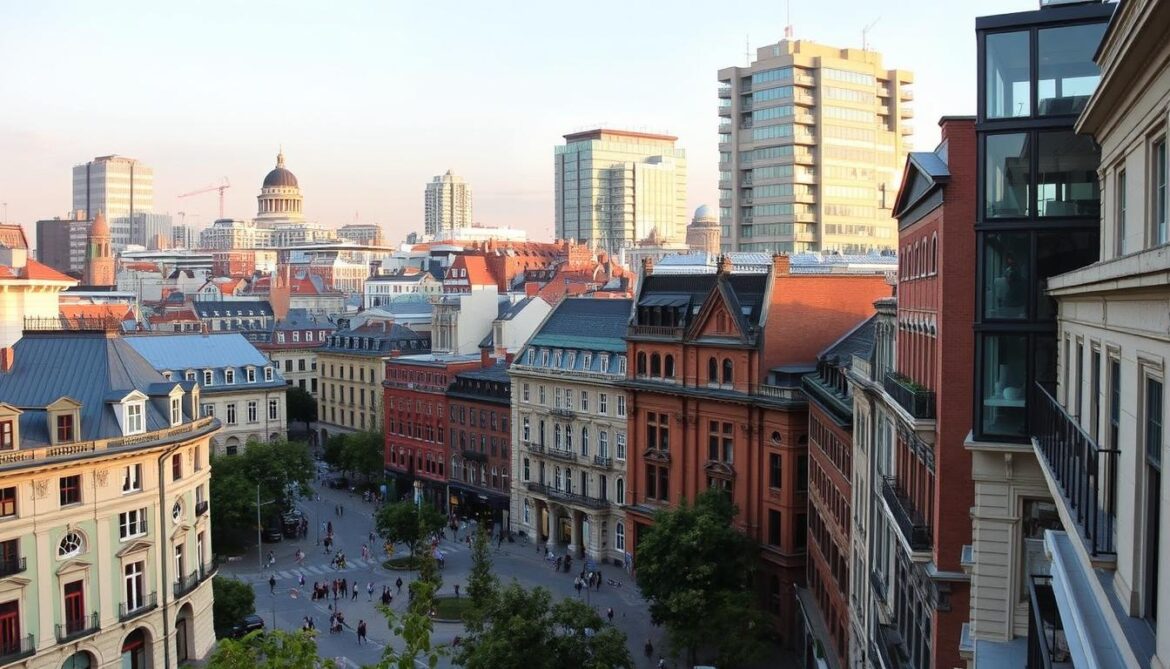
These architectural styles, each with their own unique character and historical significance, have become inextricably linked to the identity of the cities they inhabit. By preserving and integrating these iconic designs into contemporary urban planning, we not only honour the past but also create a rich tapestry of architectural heritage that will continue to inspire and captivate future generations.
Strategies for Integrating History into Urban Spaces
As cities evolve, preserving cultural legacy while embracing urban renewal becomes a delicate balance. Innovative strategies that integrate history into modern urban spaces are crucial for maintaining a city’s architectural heritage and fostering a sense of community identity. Two key approaches stand out: the adaptive reuse of historical buildings and the incorporation of historical elements in new developments.
Adaptive Reuse of Buildings
The adaptive reuse of historical structures is a powerful tool in the urban planner’s toolkit. By repurposing existing buildings, cities can breathe new life into their architectural legacy while reducing the environmental impact of new construction10. For instance, the Metrocable system in Medellín, Colombia has contributed to reducing crime rates in previously high-crime neighbourhoods10, while improvements to public spaces in Las Condes, Santiago have revitalised retail and improved safety, resulting in increased foot traffic10. The redesign of the Traditional Medicine and Herb Market in Durban, South Africa has led to significant economic growth, safer conditions, and increased opportunities for vendors10.
Incorporation of Historical Elements in New Developments
Integrating historical elements into new urban developments can create a harmonious blend of old and new, preserving a city’s cultural legacy while accommodating modern needs11. Historic buildings and landscapes play a vital role in fostering collective memory and preserving cultural heritage in urban spaces11. Preservation-based affordable housing projects leverage existing structures to reduce construction costs and address housing affordability issues11. One notable example is Council House 2 in Melbourne, Australia, which received a six-star Green Star rating in 2005 for its sustainable design and impact on the surrounding neighbourhood10.
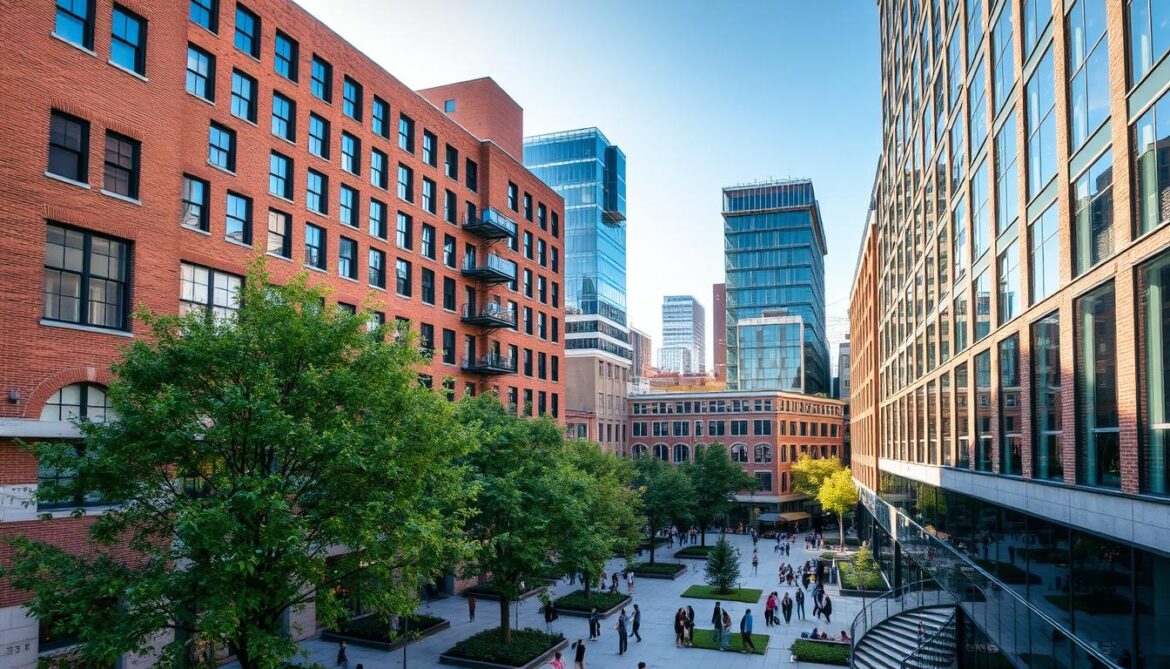
Community Engagement in Urban Design
Preserving the historical essence of cities is not merely the responsibility of urban planners and designers; it requires active community participation12. Urban design uses an explicit, public decision-making process to engage community members in the design process12. This collaborative approach ensures that the unique character and heritage of a locality are respected and celebrated in the design of modern urban spaces.
Importance of Local Input
The success of urban design initiatives that preserve history depends on the meaningful involvement of local residents and community stakeholders12. By incorporating the perspectives and needs of the people who live, work, and thrive in these historical neighbourhoods, urban designers can create designs that resonate with the community and honour its legacy13. Research by the American Planning Association indicates a positive correlation between urban design quality and community well-being13.
Case Examples of Community-Driven Initiatives
Across the world, there are inspiring examples of community-driven urban design projects that have successfully integrated historical preservation with modern urban needs13. One such case is the transformation of Detroit’s riverfront, where local residents collaborated with urban designers to revitalise the area while preserving its industrial heritage13. The result is a vibrant, accessible public space that celebrates the city’s past while providing a dynamic hub for the present-day community.
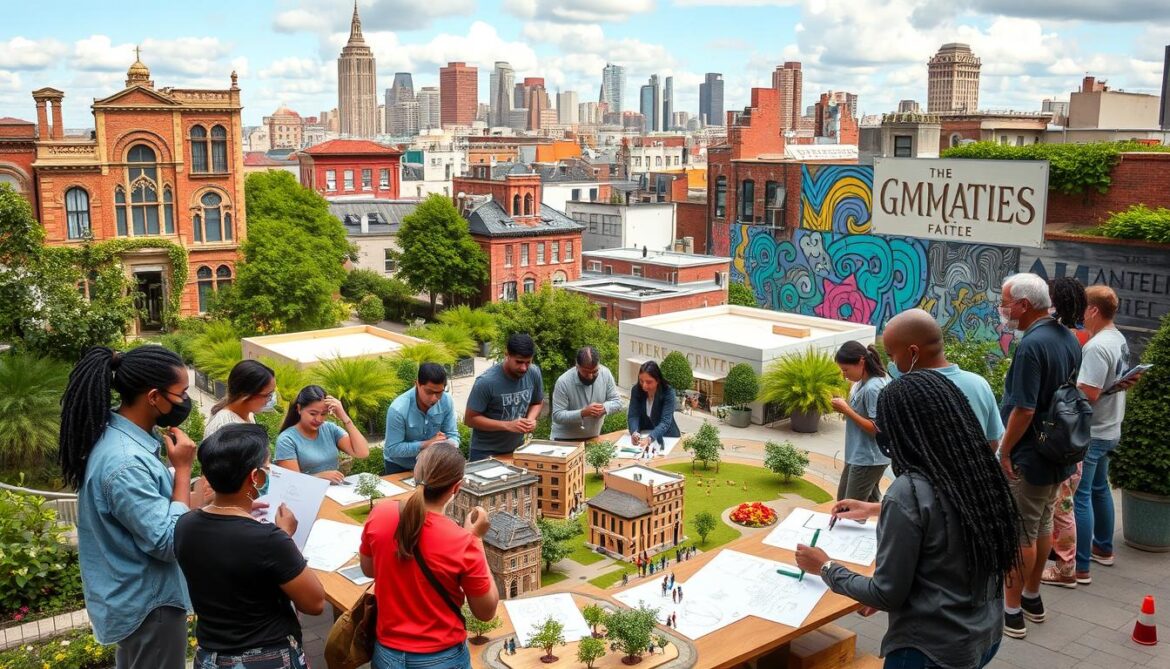
Another noteworthy example is the High Line in New York City, a public park built on an abandoned elevated railway13. This project, spearheaded by a community group, has become a global model for adaptive reuse and the integration of historical infrastructure into a thriving public space13. These case studies demonstrate the power of community engagement in shaping urban design that preserves the past while embracing the future.
“Successful urban design requires the active participation of the community. Only by listening to the voices of local residents can we create spaces that truly honour the history and character of a place.”
– Jane Jacobs, renowned urban activist and author
The Impact of Technology on Historical Preservation
Technology has revolutionised the field of historical preservation in urban design. Digital restoration techniques now allow for the accurate reconstruction and preservation of lost historical sites and artefacts14. The integration of AI in architecture and historical preservation enables the regeneration of structures or cities that have been lost to history14. Japan serves as a prime example, seamlessly harmonising cultural heritage with advanced technology, demonstrating a balance between the two14. Embracing technology has facilitated the blending of the future with the past, preserving cultural heritage for future generations14.
Digital Restoration Techniques
Innovative technologies are transforming the way we approach historical preservation15. Building Information Modeling (BIM), laser scanning, and 3D printing have enhanced the accuracy and feasibility of restoring historical buildings15. Laser scanning provides detailed 3D models for assessing building conditions and planning restoration work, while 3D printing enables the precise replication of architectural elements to repair damaged structures15. Drones equipped with advanced cameras and sensors offer detailed aerial footage, allowing for non-invasive assessments of historical sites15. Virtual and Augmented Reality technologies further enhance visualisation in conservation projects and public engagement.
Smart Cities and Heritage Management
The integration of technology in urban design has also revolutionised the way we manage and preserve cultural heritage16. Smart cities utilise digital technology and data-driven solutions to enhance residents’ quality of life and improve service efficiency16. The Internet of Things (IoT), big data, and artificial intelligence (AI) are employed to manage resources, transportation, infrastructure, and public services in real-time, while also supporting the preservation of cultural heritage16. Advanced technologies such as 3D scanning, photogrammetry, and virtual reality (VR) can digitally document and preserve cultural heritage sites, providing interactive and immersive experiences for visitors16. IoT sensors can monitor structural health, environmental conditions, and visitor traffic to predict and prevent damage, while big data analytics inform data-driven decision-making in heritage preservation16.
The role of technology in preserving culture allows for the conservation and repurposing of historical structures, fostering a sense of community and empathy among diverse backgrounds14. Language apps and online archives also contribute to safeguarding endangered traditions, ensuring that the rich tapestry of our shared history is maintained for future generations14.
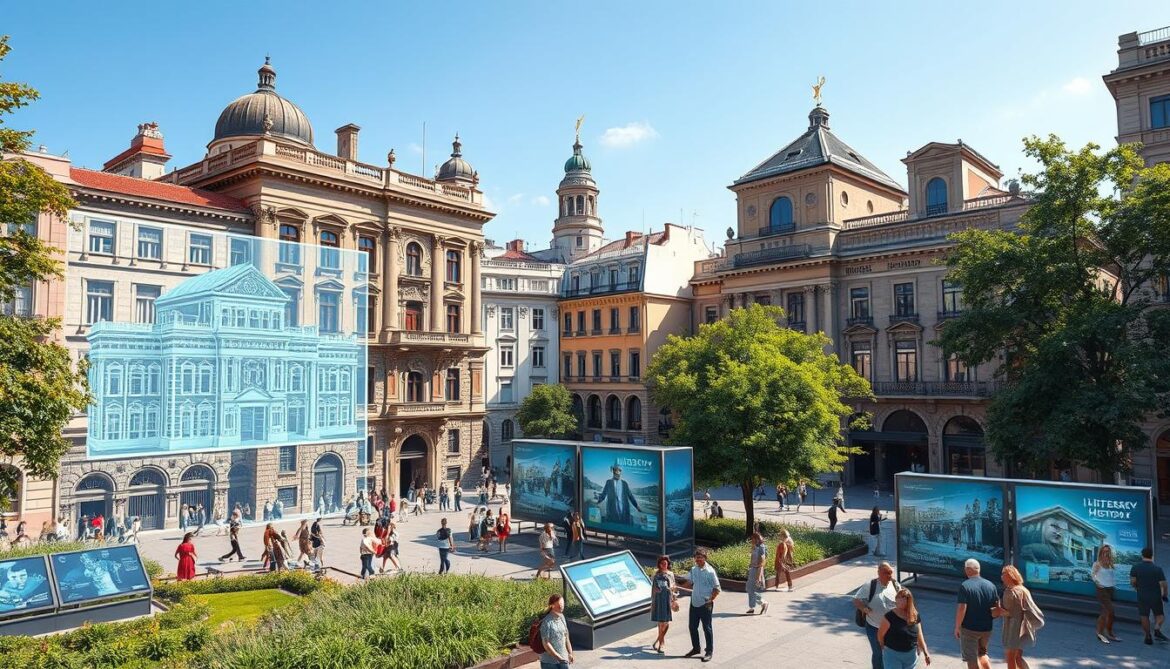
“Technology has revolutionised the way we approach historical preservation, allowing us to regenerate lost structures, document cultural heritage, and engage communities in new and immersive ways.”
Policies Supporting Historical Urban Design
Effective policies are essential for preserving the rich historical heritage within urban landscapes. Zoning regulations and heritage listings play a crucial role in protecting significant historical sites and ensuring that urban development respects and complements the existing architectural fabric17. Moreover, securing adequate funding for preservation projects is paramount in maintaining and restoring the character of these cherished urban spaces17.
Zoning Regulations and Heritage Listings
Cities around the world have implemented various zoning policies and heritage listing programmes to safeguard their historical urban environments18. For instance, the City of Berkeley in the United States has a Landmarks Preservation Ordinance, established in 1974, which allows for the designation of landmark buildings and review of permit applications for alterations, constructions, or demolitions in historic districts18. This comprehensive approach ensures that the unique architectural character of the city is preserved, even as it continues to evolve and adapt to modern needs.
Funding Opportunities for Preservation Projects
Securing adequate funding is crucial for the successful implementation of urban preservation initiatives17. Governments, private organisations, and international bodies often provide grants and financial assistance to support the restoration and maintenance of historic buildings, as well as the development of comprehensive urban design plans that integrate heritage elements17. These funding opportunities enable municipalities to invest in the long-term preservation of their urban heritage, ensuring that it remains a vibrant and integral part of the city’s identity.
“The conservation of historic urban environments is currently a critical issue in cultural heritage preservation.”17
As cities around the world grapple with the challenges of rapid urbanisation and development, the need for robust policies and funding mechanisms to support historical urban design has become increasingly apparent17. By striking a balance between preserving the past and embracing the future, policymakers and urban planners can ensure that the rich heritage of our cities continues to be celebrated and integrated into the fabric of modern urban life17.
Challenges in Preserving Urban Heritage
Preserving the rich historical tapestry of cities poses significant challenges as urban areas grapple with the competing demands of development and heritage conservation19. Cities and urban areas are the most represented types of heritage on the World Heritage List, highlighting the importance of safeguarding these cherished sites19. However, the relentless pace of urbanisation, with over 54% of the world’s population residing in urban areas as of 2016 and an expected continuous increase, particularly in low- and middle-income countries, creates immense pressure on historical urban landscapes20.
Conflicts Between Development and Preservation
The issue of heritage conservation and urban development often results in a political dilemma, with politicians viewing heritage preservation as an obstacle to development and economic growth20. Balancing the expanding needs of cities with the preservation of cultural heritage poses a significant challenge, as efforts to reconcile these competing priorities are faced by many cities globally20. The desire for progress and modernisation can lead to the demolition of historic buildings, as seen in the case of Battambang, Cambodia, where approximately 800 heritage buildings were once integrated into a ‘Heritage Protection Area’21.
Economic Pressures on Historical Sites
The economic pressures on historical sites are another critical factor in the preservation of urban heritage19. World Heritage Cities are among the World Heritage Properties that appear most often in state of conservation reports, indicating the challenges they face19. In Battambang, the decline in residential use and traditional shops within the Heritage Protection Area, coupled with a notable increase in commercial use aimed at attracting tourists, highlights the tension between preserving the city’s cultural identity and capitaliSing on its heritage for economic gain21. While heritage tourism has the potential to bolster the local economy, it can also lead to the gentrification and displacement of long-term residents, further threatening the authenticity of the historical urban fabric20.
Addressing these challenges requires a multi-faceted approach that balances the needs of urban development with the preservation of cultural heritage. Innovative solutions, such as those championed by MORROW, a company focusing on urban planning and heritage conservation, which emphasizes the integration of urban heritage conservation into broader Sustainable Development Goals (SDGs) to enhance residents’ quality of life and boost economic development, offer promising pathways forward21.

As cities continue to evolve, the preservation of their historical character and identity remains a critical priority. By navigating the complex interplay between development and conservation, policymakers and urban planners can ensure that the legacy of the past is not lost, but rather seamlessly woven into the fabric of the future.
Case Studies: Cities Leading the Way in Urban Design
As cities strive to balance the preservation of their historical heritage with the demands of modern development, a few urban centres have emerged as shining examples of successful urban heritage preservation and innovative historical urban design22. These cities have implemented strategies that seamlessly integrate the old and the new, serving as inspirational case studies for other municipalities around the world.
Edinburgh: A Blend of Old and New
The Scottish capital of Edinburgh is a testament to the harmonious coexistence of the past and the present. The city’s historic Old Town, a UNESCO World Heritage Site, boasts a well-preserved medieval layout and iconic landmarks such as Edinburgh Castle and the Royal Mile23. Meanwhile, the striking contemporary architecture of the New Town, designed in the 18th century, complements the historic structures, creating a captivating urban landscape. Edinburgh’s commitment to preserving its architectural heritage while embracing modern design has made it a shining example of successful urban heritage preservation.
Barcelona: Preserving Gaudí's Legacy
The vibrant Spanish city of Barcelona is renowned for its unique architectural identity, largely influenced by the visionary works of Antoni Gaudí22. The city has made a concerted effort to protect and restore Gaudí’s iconic creations, such as the Sagrada Familia, Park Güell, and Casa Batlló, ensuring that his innovative historical urban design continues to captivate visitors and residents alike. Barcelona’s dedication to preserving Gaudí’s legacy while seamlessly integrating it into the modern urban landscape has solidified its reputation as a leader in successful urban heritage preservation.
Rome: Balancing Modern Life with Ancient History
As one of the oldest continuously inhabited cities in the world, Rome faces the unique challenge of harmonising its ancient history with the demands of contemporary urban living24. The city has implemented various strategies to safeguard its abundant historical sites, such as the Colosseum, the Roman Forum, and the Pantheon, while also allowing for sustainable development and the integration of modern architectural elements. Rome’s delicate balance between preserving its rich cultural heritage and adapting to the needs of a 21st-century city serves as a model for other cities grappling with the complexities of urban heritage preservation.

These case studies of Edinburgh, Barcelona, and Rome demonstrate that successful urban heritage preservation and innovative historical urban design are not mutually exclusive goals222324. By embracing a holistic approach that values the past while accommodating the present, these cities have become beacons of inspiration for urban planners and policymakers worldwide, showcasing the immense potential of blending historical preservation with modern urban development.
The Future of Urban Design and Historical Preservation
The landscape of urban design and historical preservation is undergoing a transformative shift, as cities seek to balance the demands of modern development with the preservation of their rich architectural heritage. Emerging concepts like the “15-minute city,” which aims to create self-sufficient neighbourhoods where essential amenities are within a short distance, pose both challenges and opportunities for preserving the past25.
Evolving Concepts in Urban Design
As the world becomes increasingly urbanised, the need to seamlessly integrate modern elements into historical settings is more critical than ever25. Smart city initiatives, which leverage technology to enhance liveability and sustainability, are proving vital in maintaining the relevance of urban heritage. By incorporating energy-efficient technologies into historical buildings, cities can reduce their carbon footprint while preserving the architectural integrity of the past25.
Moreover, the growing emphasis on adaptive reuse, where old buildings are converted into contemporary spaces, offers a sustainable solution that honours the past while accommodating the needs of the present26. This approach not only reduces the environmental impact of demolition and new construction but also provides opportunities for lower-cost spaces, fostering diverse and inclusive communities26.
Keeping History Alive for Future Generations
Preserving urban heritage for future generations requires a multifaceted approach, encompassing education, technology, and innovative preservation techniques27. Engaging local communities in the urban planning process is crucial, as it ensures that the unique character and stories of historical sites are respected and celebrated25. Additionally, comprehensive preservation plans that integrate heritage considerations into local policies can strengthen the long-term viability of urban heritage27.
As cities continue to evolve, the future of urban design and historical preservation lies in the careful balance between respecting the past and embracing the future. By leveraging technology, fostering community involvement, and implementing sustainable practices, cities can preserve their unique identities while adapting to the changing needs of modern society252627.
FAQ
What is the role of urban design in preserving history?
How does the historical context inform modern urban design practices?
What strategies are used to balance modernity with heritage in urban design?
How do iconic architectural styles contribute to a city’s unique character?
What is the role of community engagement in urban design that respects history?
How has technology revolutionised historical preservation in urban design?
What policies and funding support historical urban design?
What are the challenges in preserving urban heritage?
What can we learn from cities that excel in blending historical preservation with modern urban design?
What are the emerging concepts and strategies for the future of urban design and historical preservation?
Source Links
- 2024 Urban Planning Is Not Boring: Discover the Excitement » Archova Visuals – https://archovavisuals.com/urban-planning-is-not-boring-discover-the-excitement/
- Urban Design: Bridging The Past, Present, And Future – https://urbandesignlab.in/urban-design-bridging-the-past-present-and-future/?srsltid=AfmBOooLfB0HF3T0UcX1IdTsGlG1irrn_HSw572d_14-fpuLLqAVi9ZE
- Historic Preservation and Urban Design – https://www.re-thinkingthefuture.com/architectural-community/a10921-historic-preservation-and-urban-design/
- What Is Urban Conservation? – https://urbandesignlab.in/what-is-urban-conservation-urban-design-lab/?srsltid=AfmBOorxtOEP9ZqZ_fakc_qKN0BmxQs56Ap36rir9mL-yYjHcL632UeB
- How Urban Conservation Can Preserve the Heritage of a City – https://urbanplanningdegree.com/how-urban-conservation-can-preserve-the-heritage-of-a-city/
- The Intersection of Historic Preservation and Urban Planning (via Passle) – https://perspectives.goulstonstorrs.com/post/102iuzu/the-intersection-of-historic-preservation-and-urban-planning
- A Quick Tour of Architectural Eras – https://www.thoughtco.com/architecture-timeline-historic-periods-styles-175996
- What are the Most Famous Architectural Styles in History? | Blog | Domestika – https://www.domestika.org/en/blog/13196-what-are-the-most-famous-architectural-styles-in-history
- Timeline Of The History Of Architecture – https://urbandesignlab.in/timeline-of-the-history-of-architecture/?srsltid=AfmBOoo2GnyVkmF0lm7aaHB8KaH0bcpUqymSZ8_eKamROHRPEutYmXCT
- Ten Strategies for Transforming Cities and Public Spaces through Placemaking – https://www.pps.org/article/ten-strategies-for-transforming-cities-through-placemaking-public-spaces
- Placemaking: The Role of Historic Preservation and Building Documentation in Creating Inspiring Public Spaces – https://soa.utexas.edu/news/placemaking-historic-preservation
- The Importance of Urban Design for Your Community – https://mrsc.org/stay-informed/mrsc-insight/march-2020/the-importance-of-urban-design-for-your-community
- What Is Urban Design? – https://www.nadigroup.com/insights/what-is-urban-design
- Cultural Preservation and the Role of Technology – https://www.re-thinkingthefuture.com/technology-architecture/a11747-cultural-preservation-and-the-role-of-technology/
- Technological Innovations in Architectural Conservation – https://www.kaarwan.com/blogs/architecture/technological-innovations-in-architectural-conservation?id=1006
- The Value of Preserving Cultural Heritage in Smart Cities – https://www.linkedin.com/pulse/value-preserving-cultural-heritage-smart-cities-rubén-bernardino-q1taf
- PDF – https://www.getty.edu/conservation/our_projects/field_projects/historic/experts_mtg_mar09.pdf
- PDF – https://berkeleyca.gov/sites/default/files/documents/13_Urban Design and Preservation Element-FINAL.pdf
- Urban conservation and management of historic centres. Recommendation on the Historic Urban Landscape – https://whc.unesco.org/en/activities/811/
- Making Room for the Past in the Future: Managing Urban Development with Cultural Heritage Preservation – https://digitalcommons.wcl.american.edu/cgi/viewcontent.cgi?article=1720&context=sdlp
- Integration of heritage conservation into urban planning – https://morrow.sg/integration-of-heritage-conservation-into-urban-planning/
- Top 10 Smart City Case Studies Pioneering Sustainable Development – https://urbandesignlab.in/top-10-smart-city-case-studies-pioneering-sustainable-development/?srsltid=AfmBOopMRUIZbk29xk4ZNcKypfvEr4X3v5cMbq-ndPStmDKLYLuwR3m-
- Downtown: A Short History of American Urban Exceptionalism – https://placesjournal.org/article/downtown-a-short-history-of-american-urban-exceptionalism/
- Urban Design Case Studies: Local Government – https://environment.govt.nz/assets/Publications/Files/urban-design-case-studies-colour_0.pdf
- Balancing modern urban design with historical preservation: Are you ready to navigate the clash of styles? – https://www.linkedin.com/advice/0/balancing-modern-urban-design-historical-preservation-7kdze
- The Fundamental Role of Preservation in New Urban Architecture| Tryba Architects – https://www.trybaarchitects.com/news/the-fundamental-role-of-preservation-in-new-urban-architecture
- Integrating historic preservation into a wider framework of urban development through comprehensive planning: an evaluation of local comprehensive plans in U.S. state capitals – Heritage Science – https://heritagesciencejournal.springeropen.com/articles/10.1186/s40494-022-00818-y






